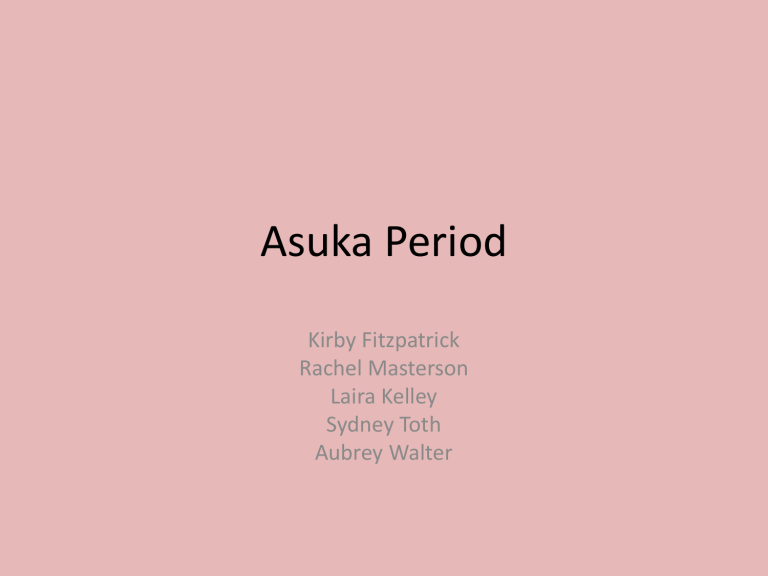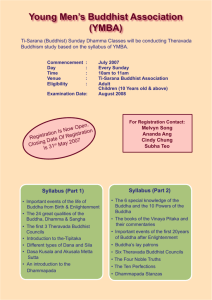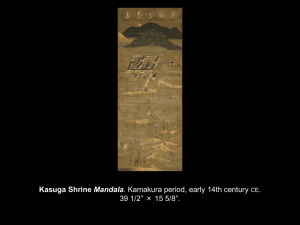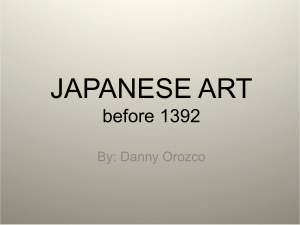Chapter11-Art of Japan Before 1279

Asuka Period
Kirby Fitzpatrick
Rachel Masterson
Laira Kelley
Sydney Toth
Aubrey Walter
• Centralized government
• Mahayanna Buddhism
• Standardized form of writing
• Assimilated Chinese and Korean influences into their culture
• New style of temple
• Buddhist icongraphy
• Many structures of this period were made of wood and burned
Horyuji Compound
• Founded in 1607
• Shotoku
• Oldest wooden temple in the world
• Rebuilt after a fire in 1670
• Contains a kondo and a 5-story pagoda inside a rectangular courtyard
• The kondo is full of Buddhist images used for worship and ceremonies
• The pagoda is a reliquary and you can’t touch or go inside it.
• Monastery monks
• Golden hall inside the Kondo
Horyuji Compound
Horyuji Compound
Buddha Shatka and Attendant Bodisatvas in the
Horyuji Condo
• 623 CE
• Guilt bronze
• 34 ½ inches tall
• May have been built by someone from Korea or
China due to the similarities in art
Horyuji Compound
Hungry Tigress Jataka
• Inside the Tamamushi
Shrine
• Lacquer on Wood
• Named after the
Tamamushi beetle because they would take the wings off the beetle and put it on the shrine to make it glimmer.
Heian Period
Valerie Sarge
Neelav Dutta
Max Zhan
Keagan Lee
Kemplin Kaley
General History and the Fujiwara
Family
• The Heian period began with the movement of the capital to Heian-kyo, now called Kyoto, in 784.
• Though the Japanese emperor was in power nominally, the Fujiwara family held the most influence.
• Towards the end, the warrior classes gained more power, leading into the Kamakura
Shogunate.
Tale of Genji
• The Tale of Genji, one of the earliest books, was written by Lady Murasaki Shikibu (family name Murasaki), a court lady.
• The book describes the life of the illegitimate son of an emperor.
• Illustrations were made with mineral colors and were often from a bird’s eye perspective, with blown-away roofs.
Tale of Genji
Illustration from the Tale of Genji
The Pillow Book
• Written by a contemporary of Lady Murasaki,
Lady Sei Shonagon.
• Contains notes and musings about court life.
Pillow Book
Sei Shonagon
Hiragana and Katakana
• As compared to the more traditional kanji system, the kana systems, including both hiragana and katakana, represent individual syllables as opposed to complete words.
• Said to be developed by the Buddhist priest
Kukai; influenced highly by Chinese scripts.
Hiragana and Katakana
• Hiragana are generally used as a common cursive script, while katakana are more specified for use in writing foreign words.
• Their use contributed to a boom in literature, including a form of poetry called the waka. Such poems were compiled in the Ishiyama-gire, written by the Thirty-Six Immortal Poets.
• Kana script is used in the Tale of Genji and the
Pillow Book.
Styles of Japanese Script
Comparison of katakana, kanji, and hiragana
Yamato-e
• Yamato-e was the most common style of Heian painting, derived from Tang Chinese paintings.
• Characteristics include the depiction of many small figures, careful drawing of backgrounds, and the use of brown clouds to cover unimportant details.
• Illustrations can be narrative or simply aesthetic.
• Yamato-e were used in both the Tale of Genji and
Pillow Book.
Yamato-e
Example: see small figures, detail, and brown clouds obscuring unimportant parts.
Buddhism
• Buddhism was a prominent religion in Japan during the Heian period, spreading in sects such as Tendai and Shingon.
• This is evident in art. The Great Buddha Hall, the largest wooden structure in the world, contains a great deal of art.
• Mandalas are used in both teaching and worship.
Buddhist Art: The Great Buddha Hall
Outside of the Great Buddha Hall
Buddhist Art: Womb World Mandala
‘Map of the Cosmos’
Joined-Block Wood Sculpture
• Due to the natural cracking of wood sculptures, Japanese sculptors created a new method.
• They cut the wood into smaller blocks to reduce shrinking and cracking and to allow for specialization and division of labor.
• The technique is credited to Jocho.
• Used to produce the Amida Buddha.
Joined-Block Sculpture
Heian Buddha statue
Kamakura Time Period
Jake Tapia, Joey Avioli, Domonique
Wilson, Emily Norton, Gabbi Thatcher
Emaki Hand Scrolls
• Emaki is a horizontal, illustrated narrative form created during the 11th to 16th centuries in Japan. It combines both text and pictures, and is drawn, painted, or stamped on a handscroll.
They depict battles, romance, religion, folk tales, and stories of the supernatural world.
Night Attack on the Sanjo Palace
• Night Attack on the Sanjo Palace
• Savage Depiction of Warfare
• Sense of violence
• Fire, War, and Energy
Pure Land Buddhist Art
• By the beginning of the Kamakura period, Pure Land Buddhist beliefs had swept throughout Japan, and several charismatic priests founded new sects to preach this ideology. They traveled all around the country spreading new gospel, which appealed to people of all levels of education and sophistocation.
Kuya
Kuya Preacher
Before 1207 CE
Painted wood with inlaid eyes
46.5 inches
Raigo Paintings
• Pure Land Buddhism taught that even one sincere invocation of the sacred chant could lead the most wicked sinner to the Western
Paradise. Paintings called raigo were created depicting the Amida Buddha, accompanied by bodhisattvas, coming down to earth to welcome the soul of the dying believer.
Originated in China, but the Japanese perfected.
Descent of Amida and the Twenty-Five
Bodhisattivas
• Depicting
Amida Buddha
• Golden cords attached to the painting so a dying person could pass their soul to
Amida who would direct them to paradise
Zen Buddhist Art
• Later part of the period
• Introduced to Japan from China
• Zen monks lived very differently than the monk
Kuya
• Kuya relied on generosity of believers whereas
Zens were more simplistic and responsible for themselves
• Zen resembles the original teachings of Buddhaemphasizes individual enlightenment through meditation
Nara Period
(645-794)
• Athena Kern
• Andrew Brennen
• Alice Liu
• John Stokes
History
• Named for Japan’s first Permanent imperial capital founded in 710
• Population Boom due to imperial
Bureaucracy inspired by China---200,000 people
Temples/Shrines
• A result of the strong central authority
• Dwarfed those built previously
Nara Park
Todaiji
• The grandest of the Buddhist Temples in
Nara Park
• Emperor Shomu
• Headquarters of the vast network of branch temples throughout the nation
• Public Religious ceremonies
Daibutsuden
• Found in
Todaji and
Nara Park
Great Buddha Daibutsu
Engraved Bronze- possibly from original lotus petals
Reconstructed Statue
The Shosoin
• Imperial Repository
• Contains 9000 objects
Huge opening ceremony
Daibutsudenlargest wooden structure in the world
PREHISTORIC JAPANESE ART
Christian Wright
Lydia Livas
Monty Farish
Sai Yalla
Maria Ortiz
Jomon
• Early pottery
• Earthenware vessels
– Low Fire
• Imitation reed baskets
• Dogu
Dogu
Another Dogu
Jamon pottery
Yayoi
• Rice Cultivation
• Large, permanent settlements
• Hieratic society develops
• Metal technology brought by Korean settlers
– Weapons
– Bells
• Iron later developed
Kofun
• Based off type of burial ground
• Oldest era of recorded japanese history
• Imperial system
• Emperor descended from shinto dieties
• High Fired ceramic ware
• Tombs- shaped like large key holes
Hanewa
• Simple cylinders that may have held jars for ceremonial offerings
• Gradually living creatures were added to haniwa repertoire
• Human figures by 6 th Century
• Clay bodies- unglazed
• Never perfectly symmetrical
Hanewa figure
Shinto
• Religious system
• Centers around family and national devotion
• Kami deities
The Isle Shrine
• Main deity Amateretasu
– Sun Goddess
• Dates from first century CE
• Rebuilt every 20 years
• Only imperial family and priests are allowed









